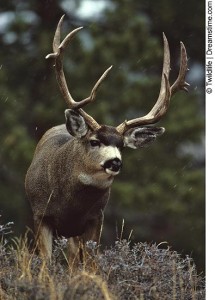Secret Bowhunting Tip: Putting in the Time
Bowhunting in August sometimes feels like doing time. Spending sixteen hours straight in the woods can be incredibly boring, hot, and seemingly futile. Because deer are most active in the morning and evening, most hunters return to camp for lunch and a nap during the day, and then head back to the field in the afternoon. But hunters beware: your odds of bagging a big buck at midday might be low, but your odds of bagging a buck at camp are near zero. However, if you learn a little bit about mule deer daytime habits, you can increase your odds of success.
In low hunter pressure areas, bucks bed down for the day around 9:00 a.m. Between 11:00 a.m. and 1:00 p.m. deer get up for a short time to stretch, grab a quick bite, and maybe change beds to avoid the changing sun angle. Then, between 3:00 p.m. – 4:00 p.m. they unbed again to use the restroom. Depending on factors such as temperature, cloud cover, and pressure, bucks will either continue to feed or bed down until evening.
The reason we can count on these times is simple: Mule deer are browser-feeders and their digestive systems run like clockwork. Since a buck is most vulnerable when he rises from bed, we can watch for them to move during the slower midday hours.
When the hunters roll into high-pressured public areas, deer change their behavior quickly. The worst place I know of is Monte Cristo in Northern Utah. I’ve hunted this area for several years and never saw a big buck up and feeding during the day. Eating may be the primary drive for deer, but sheer survival is more important than eating.
When their lives are on the line, deer will bed before daylight and remain bedded all day until the sun goes down. They simply adopt a temporary nocturnal lifestyle in order to survive. When hunting nocturnal bucks, don’t get discouraged. They still exist somewhere; you just have to find them.
When the hunting pressure is on, bucks leave open country where they might live all summer and move to steep secondary ridges where there’s more protective cover. When looking for pressured bucks, begin your search in the steepest and thickest terrain possible. Sometimes they move to heavily wooded north-face, dark timber where elk like to live.
Learning a little about a deer’s diet will help you pin-point good secondary areas. Depending on the time of year, the primary food sources for deer in the West are bitterbrush, cliff rose, aspen leaves, and sage brush. It’s imperative that you learn you identify key food sources in your area. The best method to determine a deer’s primary food source is to cut the stomach open. Of course, you’ll have to harvest one first.
Once you’ve located these secondary ridges and hideouts–based on actual deer sightings, tracks and droppings, or other sign–the next step is to get there before first light. Deer that aren’t feeding midday still have to eat at night, and they won’t be traveling far to bed down for the day.
When hunting secondary ridges, start by still-hunting the steepest and thickest terrain you can find. Move very slowly and glass every ten steps or so. There’s nothing more difficult than hunting bedded bucks, but remember you have all day to do so!
It’s also a good idea to locate nearby water sources. Deer don’t require daily water because they get most of their moisture from the plants they eat. But they still need to water every few days, and even more frequently in hot, arid regions. Any small seep or spring will do. One way to locate water is too look for willows. Willows are easy to spot because of their tall, reddish stems. As an aside, deer also love to eat willow branches.
In my time, I’ve seen some real monster bucks up and feeding during midday, however, this is rare. Whenever possible, spend the entire day in the woods and it will eventually pay off. Hunt smarter, not harder. The fastest way to increase bowhunting success to put in more time afield.
For other “secret tips” to bowhunting success, refer back to these previous articles:
Secret Tip #1: Weight is Everything
Secret Tip #2: Success is a Decision

